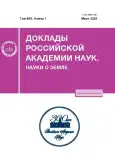NEOTECTONIC DISLOCATIONS AT THE BARENTS SEA SHELF AND THEIR GENESIS ACCORDING TO THE MORPHOMETRY OF BATHYMETRY, SEISMIC SECTIONS AND THE DEEP MANTLE STRUCTURE
- Autores: Sokolov S.Y.1, Abramova A.S.1, Shkarubo S.I.2
-
Afiliações:
- Geological Institute Russian Academy of Sciences
- JSC “Marine Arctic Geological Expedition”
- Edição: Volume 509, Nº 1 (2023)
- Páginas: 62-68
- Seção: GEODYNAMICS
- ##submission.dateSubmitted##: 14.10.2023
- ##submission.datePublished##: 01.03.2023
- URL: https://journals.rcsi.science/2686-7397/article/view/135748
- DOI: https://doi.org/10.31857/S2686739722602484
- EDN: https://elibrary.ru/THWTST
- ID: 135748
Citar
Texto integral
Resumo
The paper provides a comprehensive analysis of the morphometric attribute “general curvature” for the bathymetry of the Barents Sea, seismic and seismoacoustic data containing in the wave field patterns tectonic faults emerging to the surface, a fault network of the sedimentary cover confirmed by seismic surveys, and seismotomographic data showing the heterogeneous deep structure by the distribution of seismic wave velocities in the upper mantle. The analysis of these data showed the presence of a causal relation between rheologically heterogeneous and mobile blocks of the upper mantle and the crystalline part of the Earth’s crust with the deep fault network, emerging on the bottom surface and being a relief-forming factor that forms characteristic domains with different textures performed by the morphometric attribute “general curvature”.
Palavras-chave
Sobre autores
S. Sokolov
Geological Institute Russian Academy of Sciences
Autor responsável pela correspondência
Email: sysokolov@yandex.ru
Russian Federation, Moscow
A. Abramova
Geological Institute Russian Academy of Sciences
Email: sysokolov@yandex.ru
Russian Federation, Moscow
S. Shkarubo
JSC “Marine Arctic Geological Expedition”
Email: sysokolov@yandex.ru
Russian Federation, Murmansk
Bibliografia
- Крапивнер Р.Б. Признаки неотектонической активности Баренцевоморского шельфа // Геотектоника. 2007. № 2. С. 73–89.
- Мусатов Е.Е. Структура кайнозойского чехла и неотектоника Баренцево-Карского шельфа по сейсмоакустическим данным // Российский журнал наук о Земле. 1998. Т. 1. № 2. С. 157–183.
- Antonovskaya G.N., Basakina I.M., Vaganova N.V., et al. Spatiotemporal Relationship between Arctic Mid-Ocean Ridge System and Intraplate Seismicity of the European Arctic // Seismol. Res. Lett. 2021. V. 92. P. 2876–2890. https://doi.org/10.1785/0220210024
- Jakobsson M., Mayer L.A., Bringensparr C. et al. The International Bathymetric Chart of the Arctic Ocean Version 4.0 // Nature. Scientific Data. 2020. V. 7. № 176. https://doi.org/10.1038/s41597-020-0520-9
- Florinsky I.V. Quantitative topographic method of fault morphology recognition // Geomorphology. 1996. V. 16. № 2. P. 103–119.
- Jordan G. Morphometric analysis and tectonic interpretation of digital terrain data: a case study // Earth Surface Processes and Landforms. 2003. V. 28 (8). P. 807–822. https://doi.org/10.1002/esp.469
- Jordan G., Meijninger B.M.L., Hinsbergen D.J., et al. Extraction of morphotectonic features from DEMs: Development and applications for study areas in Hungary and NW Greece // International Journal of Applied Earth Observation and Geoinformation. 2005. V. 7 (3). P. 163–182. https://doi.org/10.1016/j.jag.2005.03.003
- Ramli M.F., Yusof N., Yusoff M.K., et al. Lineament mapping and its application in landslide hazard assessment: A review // Bull. Eng. Geol. Environ. 2010. V. 69. № 2. P. 215–233.
- Kokinou E., Panagiotakis C. Automatic Pattern Recognition of Tectonic Lineaments in Seafloor Morphology to Contribute in the Structural Analysis of Potentially Hydrocarbon-Rich Areas // Remote Sensing. 2015. V. 12 (10). 1538. https://doi.org/10.3390/rs12101538
- Panagiotakis C., Kokinou E. Linear Pattern Detection of Geological Faults via a Topology and Shape Optimization Method // IEEE Journal of Selected Topics in Applied Earth Observations and Remote Sensing. 2015. V. 8. № 1. P. 3–11. https://doi.org/10.1109/JSTARS.2014.2363080
- Conrad O., Bechtel B., Bock M., et al. System for Automated Geoscientific Analyses (SAGA) v. 2.1.4 // Geosci. Model Dev. 2015. V. 8. https://doi.org/10.5194/gmd-8-1991-2015
- Harrison J.C., St-Onge M.R., Petrov O.V., et al. Geological Map of the Arctic 1:5 000 000. Geological Survey of Canada. 2008. Open file report 5816.
- Карта дочетвертичных образований. T-37-40 (Земля Франца-Иосифа, южные острова). Государственная геологическая карта Российской Федерации масштаба 1:1 000 000 (новая серия). Лист 1. МАГЭ, ПМГРЭ, ВНИИОкеангеология, 2004. Отв. редактор Б.Г. Лопатин.
- Виноградов А.Н., Верба М.Л., Верба В.В. и др. Основные черты геологического строения Евро-Арктического региона // Строение литосферы российской части Баренц-региона. Под ред. Н. В. Шарова, Ф. П. Митрофанова, М. Л. Вербы, К. Гиллена. Петрозаводск: Карельский НЦ РАН, 2005. С. 16–39.
- Шипилов Э.В. К тектоно-геодинамической эволюции континентальных окраин арктики в эпохи молодого океанообразования // Геотектоника. 2004. № 5. С. 26–52.
- Хуторской М.Д., Леонов Ю.Г., Ермаков А.В. и др. Аномальный тепловой поток и природа желобов в северной части Свальбардской плиты // ДАН. 2009. Т. 424. № 2. С. 318–323.
- Старцева К.Ф., Никишин А.М., Малышев Н.А. и др. Геологическая и геодинамическая реконструкция Восточно-Баренцевского мегабассейна на основе анализа регионального сейсмического профиля 4-АР // Геотектоника. 2017. № 4. С. 51–67.
- Сироткин A.H., Шарин В.В. Возраст проявлений четвертичного вулканизма в районе Бокк-фьорда (архипелаг Шпицберген) // Геоморфология. 2000. № 1. С. 95–106.
- Казанин Г.С., Павлов С.П., Шлыкова В.В. и др. Сейсмо-геологическое строение Печорского и юго-восточной части Баренцева морей на основе интерпретации каркасной сети сейсмических профилей МОВ ОГТ 2Д // Геология и геоэкология континентальных окраин Евразии. Выпуск 3. М.: ГЕОС, 2011. С. 59–81.
- Bungum H., Ritzmann O., Maercklin N., et al. Three-Dimensional Model for the Crust and Upper Mantle in the Barents Sea Region // Eos. 2005. V. 86. № 16. P. 1–3.
Arquivos suplementares














